
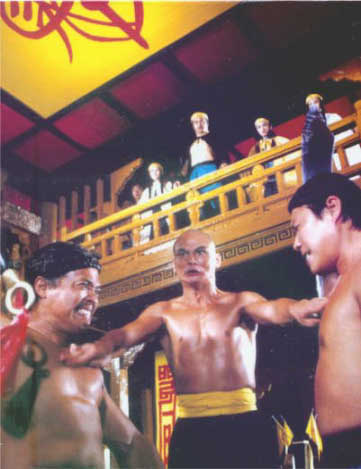


Shaw Brothers in the late 70s were still active and occasionally producing popular films such as Legendary Weapons of China (Liu:1982) and House of 72 Tenants (Yuen:1973) however, box office revenues were not overall matching Golden Harvest‘s. Also independent studios were trying to capitalise on the kung fu phenomenon set out by Bruce Lee and this began to devalue the uniqueness of the genre. This was a chance for Shaw Brothers to capitalise and regain their dominance in the industry.
INDUSTRY
The death of Bruce Lee had put the Hong Kong film industry into a unique position. There were two major studios to produce high quality films but no major martial arts stars to rival the appeal of Lee in the still popular genre. Through the success of films such as Way of the Dragon, Golden Harvest now had the money to rival Shaw Brothers and compete on the same level of quality and "by 1975, [Raymond Chow] controlled the largest theatre circuit along with scores of screens throughout Asia" (Bordwell, 2000a:68). The kung fu genre was at its peak after Bruce Lee’s dominance and companies tried to exploit this with a wave of cheap movies but by having no strong star power, the quality began to dip. Shaw Brothers in particular as mentioned in the previous chapters capitalised on popular generic trends (in this case martial arts) and tried to saturate the market with similarly styled films like in 1972 where twenty-six out of thirty seven films from Shaw Brothers output were wuxia (1). Yet by putting most of their energy into one particular genre, once the kung fu film began to lose popularity they had few other stars groomed for stardom.
The rise of local television networks in Hong Kong however produced a new wave of stars into the industry yet Shaw Brothers failed to capitalise. For a period in the early 70s, production of Cantonese movies severely dropped (zero in 1972) in the face of the dominant Mandarin studios like Shaw Brothers (2) because small local based studios could not possibly compete with the quality and exportability of Mandarin films as mentioned in Chapter 1. Top Cantonese directors such as Chor Yuen were forced to produce films in the Mandarin language when Cantonese cinema vanished from the screens, demonstrating the impact the big studios of Hong Kong had on the industry and its talent. However during this period, television became popular (3) where local networks could specifically target the Hong Kong audience as its prime demographic.
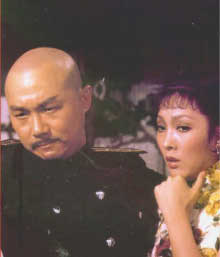
As these TV shows were directed at the local audience, the programs were broadcast in Hong Kong’s most common dialect; Cantonese and when television stars moved into filmmaking such as Michael Hui they opted to make Cantonese movies over Mandarin (with one reason being that the local audience had become accustomed to these local entertainers speaking Cantonese through television drama series and variety shows). These television performers could achieve this at Golden Harvest which supported local independents such as Michael Hui‘s company. Hui had worked briefly for Shaw (4) but the creative freedom at Golden Harvest had enabled him to focus on Cantonese features where this language associated with the local audience allowed a sense of identity not present in the Mandarin films of Shaw Brothers. With the fear of the 1997 handover to China looming, Hong Kong was a colony with an identity crisis but with the rise of Cantonese cinema this led to a local voice being formed which spoke directly to the Hong Kong audience. This contrasts with how Shaw Brothers were trying to target a wider Chinese market by focusing on the Mandarin language and so their films tended to stay away from Hong Kong themes and politics to appeal to the larger audience without a clear identity (with narratives set in unspecific historical pasts such as in King Hu’s wuxia entries). Previously Cantonese films could not compete with Shaw’s wealth and so there was no comparison in quality, but with access to funds from Golden Harvest and its support of independent satellite groups, the local industry could flourish and the Hong Kong audience would stray away from Shaw‘s wider Chinese marketed films in favour of local varieties.
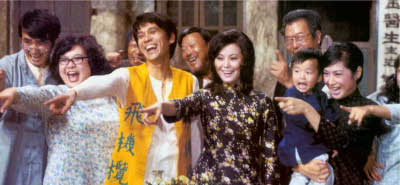
The interesting thing is Shaw Brothers had actually helped start the resurgence of Cantonese films in part by owning majority shares in the local television network HK-TVB and releasing the film House of 72 Tenants (5) but failed to capitalise on this revival because Cantonese stars and filmmakers like Michael Hui refused to work for the studio system when they could produce films for independent companies with freedom and better money. Also with the return of a strong Cantonese cinema, Hong Kong companies could make local films cheaper without the worries of competing in an international market (leading to many independents rising) and be without high studio overheads that burdened the prestigious Shaw Brothers (6) and the running of Movietown.
Shaw’s rivals in Hong Kong after the Cantonese resurgence were numerous and powerful unlike the days of the big studios where Shaw Brothers’ only major threat was MP and GI. This revival which Shaw had played his part in was another element in the studio’s demise and evidentially led to a dependence on their television department. Of course this rise in the popularity of television meant big budgeted studio features were at risk with the possibility of audience’s staying at home. So Run Run Shaw at least realised that the days of the studios in Hong Kong were numbered and was prepared to move into this new format by owning shares in a network.
Along with the wave of cheaply made independent kung fu films exploiting the legacy of Bruce Lee, the rise in quality of local regional specific films support by Golden Harvest and Cinema City weakened the status of Shaw Brothers whose high budgeted features had been a selling point to audiences. The success of Michael Hui’s Cantonese films (and later Jackie Chan) proved that the local market was dependable to make a profit from and so Hong Kong specific films could rise (7).
AESTHETICS
If it was Michael Hui who consolidated the new trend of Cantonese films in the industry, it was Jackie Chan who successfully combined the waning martial arts film with social comedy to create a new style of film. As previously noted, the kung fu movie was in crisis since "in terms of genre, it is true that the 1970s was unbalanced by the tendency of the industry to mass-produce martial arts pictures" (Teo, 2000:100). Many independent companies were searching for the “next” Bruce Lee with many clones such as Bruce Li and Bruce Le performing in cheaply made kung fu films, trying to cash in on the star power of Lee. This was simple to achieve through small independent companies since the kung fu film was much easier to make than the wuxia film before. There was no need for special effects or props as the spectacle was in watching men fight with their own strength. So this allowed a wave of poorly made kung fu films from independents which devalued the quality of the high budgeted Shaw Brothers output as people were growing sick of these Bruce Lee imitations and the constant barrage of kung fu films based on the tired motif of revenge. Shaw Brothers themselves were far from being inventive, reusing successful older formulas that were selling for example Chang Cheh’s films "were increasingly mechanical, running like clockwork, with action sequences and characters being repeated" (Teo, 1997:103). Chang’s films such as 5 Shaolin Masters (1974), Shaolin Temple (1976), and Two Champions of Shaolin (1978) repeatedly dealt with the basic narrative of the destruction of Shaolin Temple by the Manchus and the subsequent avengement by Shaolin masters (but typically still featuring the self sacrificing hero styled from The One Armed Swordsman). Chang Cheh’s films often still featured characters based on the turbulence of the late 60s not updating this model for modern audiences. Also if any upstart film company could make an average kung fu film, then to save the popularity of this genre, the model had to be updated.

The want for change clearly paved the way for the Cantonese comedy and more specifically the kung fu comedy. This was not exactly a realistic form of fighting but an over extended style of Peking Opera since "Chan and his contemporaries drew on the Peking Opera influence. Indeed, they intensified it, partly by absorbing Lee's lesson that the action should be filled with emotion, partly by creating long routines displaying varied techniques and presenting a smoothly accented rhythm" (Bordwell, 2000a:56). This was the perfect balance that the Hong Kong audiences needed. The mix between the traditional arts and the modern themes represented in characterisation and comedy created a unique event to rejuvenate the genre from the cheap exploitation films which had devaluated it. While Chan’s outlandish moves on screen couldn’t be mistaken for real fighting moves, it is the fact that he is performing the stunts and sequences which differentiate him from King Hu and Chang Cheh actors (and even Bruce Lee who required a stunt double for acrobatics such as flips (8)). With the 15 minute fight at the end of Drunken Master (Yuen:1978) filled with athleticism and comedy, Chan had re-energised the martial arts fight scene building on the advances Bruce Lee made such as erasing constructive editing to demonstrate that there was no camera trickery involved.
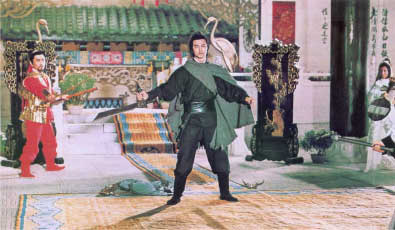
Shaw’s output of the time was making profit but not on the same level of Golden Harvest’s in terms of box office. For example one of Shaw’s most popular films of the 1980s was Legendary Weapons of China making HK$9,913,000 at the box office. But compare this to Jackie Chan’s Project A (Chan:1983) which came out the following year with HK$19.3 million (9) and the tastes were clearly in favour of Cantonese kung fu comedy. Other examples include The Private Eyes (1976) from Michael Hui making 8.5 million HK dollars compared with Shaw’s martial arts film The Killer Clans (1976) making 1.5 million HK dollars. I do want to stress that box office receipts are not necessarily a sign of quality and while a great deal of Shaw Brothers later output could be seen as bland and repetitive (especially Chang Cheh's reluctance to move away from formula), there were undoubtedly some classic films still being made by the studio, especially from an auteur such as Chor Yuen. His films such as Clans of Intrigue (1977) and The Magic Blade (1976) reinvented the wuxia genre when it was virtually moribund and of course as mentioned earlier, his film House of 72 Tenants revitalised Cantonese cinema. So it is true that Shaw Brothers had some energy left but the market was no longer theirs to dominate and the tastes of the audience were generally elsewhere with contemporary Cantonese comedy. Perhaps part of the reason for this contrast could be that Shaw realised that they could cut costs by using martial arts choreographers to shoot whole movies, losing trained directors like Chang Cheh who privileged story as much as the fight scenes. The choreographers on the other hand would focus on the fights, with Shaw Brothers films becoming production line fight scenes losing quality and any need for “actors”.
Jackie Chan however realised the importance of narrative and characters to match the action and so created an interesting hero that would not face his problems with violence but with self-mockery and endurance. This was a regular person who beat his opponents through luck and determination, rather than natural kung fu talent and so this was a hero that working class Hong Kong audiences could relate to unlike the advanced Shaolin masters of Shaw‘s late 70s output like in Executioners From Shaolin (Liu:1977).
REPRESENTATION
Hong Kong society had been constantly progressing while Shaw Brothers were in production. The late 1960s were times of chaos and through Chang Cheh’s hero, there was an embodiment of violent sacrifice. But the late 1970s "was an unsettling time of double-digit inflation, economic recession, stock market crash, rampant crime and corruption" (Zhang, 2004:180). There was no violence in the streets and living was generally improved under Governor MacLehose but uncontrollable problems such as the stock market crash presented discomfort. This was a time when comedic relief was needed and Michael Hui and Jackie Chan in particular exploited this.
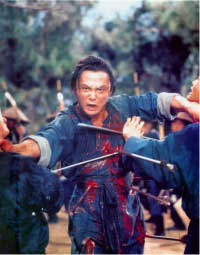
This type of hero progressed further from Bruce Lee’s character type which had become a stereotype with the “clones”. Lee’s character in The Way of the Dragon (discussed in Chapter 2) is portrayed as a “country bumpkin” but is still an intense kung fu fighter. In Jackie Chan’s Young Master (Chan:1980), the hero is also a naïve buffoon but importantly, he lacks fighting skills and a “hard body”. He only defeats the villain by luck and in the end credits he is covered in bandages, victorious but only through determination (10). Shaw Brothers heroes like Jimmy Wang Yu created the illusion of them being masters through effects and choreography but Chan created the opposite illusion of being a regular working class hero. Whereas a film like Shaw Brothers The Heroic Ones punishes the hero for being a working class shepherd (who dies from jealously of others due to his rise from lower status to riches), the new comedy films focused on turning weakness into strength and class did not dictate power (11).
As the economy improved "the advent of the affluent lifestyle and the emergence of the middle class led to the belief that the institutionalisation and regulation of society (in 1976, the dream of hitting it rich was institutionalised with the introduction of the lottery) could bring about new opportunities for the people" (Lui, 2003:172). Economic development created self confidence (unlike the late 60s) so Chan's characters that use luck and brawn to head off disaster were more accepted than violent sacrificing heroes. Since in the 60s there was no consensus for social order, to sacrifice yourself for greater goals was part of the ideology but in the 70s with economic stability, there were other ways to win battles.
Chan even reinvented classical Cantonese tales to relate to the wave of localised films targeting specifically the Hong Kong audience. His comedy take on the Cantonese popular series, Wong Fei Hung in Drunken Master was an indicator of Cantonese cinema moving into modern times and eventually in Police Story (Chan:1985) he set the action in the present day city and with this sense of time and place, Jackie Chan represented modern Hong Kong. On the other hand some of Shaw’s biggest directing names over the decades such as Inoue Umetsugu from Japan or Chor Yuen from Guangzhou, China could not infuse their films with the same levels of Hong Kong familiarity such as the natives Hui and Chan. Even their stages and sets in the studio helped add to distance the audience from the social realism of Hong Kong.

Shaw Brothers were quickly becoming trend followers with output such as The Master (Lu:1980) copying the storyline almost identically of Chan’s film Snake in Eagle Shadow (Yuen:1978), reflecting a lack of innovation. This left Shaw’s Mandarin period films (which avoided local politics in favour of myths and sentiments) trailing the infused local spirit of Jackie Chan’s Hong Kong films. Shaw’s films were still often featuring their China focused plots which on some levels worked for the International Chinese market but suffered in the local territory where Michael Hui with his political/social satires reigned supreme at the box office. Even Bruce Lee’s image was often more about Chinese empowerment than specifically Hong Kong but it had been important because it signalled change and the new wave stars developed on that. With Michael Hui’s and Jackie Chan’s success, it allowed the local Cantonese-dialect pictures to flourish and with the local language being represented on screen, the audience could see heroes who represented Hong Kong rather than the more generic Chinese sentiments of Shaw Brothers.
By this stage Shaw Brothers rivals were numerous and powerful and the days of the studio system were truly over. In 1985 they stopped production, moving their resources into television…
ENDNOTES FOR CHAPTER 3
(1) From (Law, 2003:138). This also led to a lot of repetition of narrative.
(2) Information from The Cinema of Hong Kong (Stephen Teo, 2000:91).
(3) The popularity of local television was due to the fact that ”in 1972, 72 percent of households had television sets” (Teo, 2000:91 ) which allowed for the rise of new Hong Kong talent. Many Cantonese performers were forced to work on television, since they were moved away from the film industry by Mandarin features and television was cheaper to produce.
(4) They had worked together on the film The Warlord (1972). But losing Michael Hui to the rivals just as they had failed to sign Bruce Lee, showed again the weakness of Shaw’s rigid studio system against independent satellite companies and also their failure to predict star potential
(5) House of 72 Tenants was an extremely popular Cantonese film from Shaw Brothers and helped bring prestige back to the language in cinema.
(6) So Shaw’s with their high costs of running Movietown had to produce these extravagant films for the international Chinese market rather than the domestic market, as they needed the larger returns. Independent companies could easily just make films for the local public as they could be made cheap but Shaw Brothers required more than that market for profit.
(7) Kung fu is heavily associated with Cantonese cinema (with the kung fu series of Wong Fei-hung being a famous Cantonese entry). The rise of comedy kung fu can clearly be seen linked with a return to Hong Kong traditions.
(8) Chan highlights the difference between special effects and realistic aesthetics by advertising the danger of the stunts he performs and that he does not use camera tricks like King Hu. Chan utilises outtakes in his films to prove that no stuntman was involved, creating an off-screen persona that is as powerful as his on-screen characters.
(9) Box Office figures taken from www.hkcinema.co.uk
(10) If Bruce Lee’s hero could be related to because his body had become perfect through training, Jackie Chan’s hero who doesn’t need any abilities but luck and adaptability to win, could be even more closely related to by the audience.
(11) Chan’s persona who could relate to both children
and adults. The rebellious nature of Chan’s character and his slapstick
comedy targets the youth demographic while his characters confidence projected
the vision of Hong Kong entrepreneur spirit who refuses to give up despite
the odds against him, unlike the self sacrificing hero or immortal warrior.